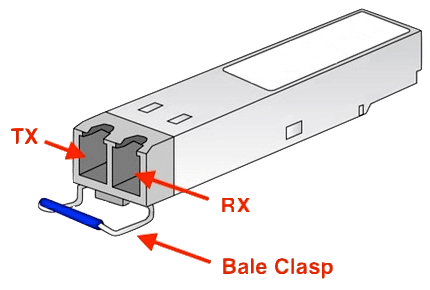Identifying SFPs
(Small Form-factor Pluggable)
SFP Media Types:
- Copper SFP: Transmit the signal with traditional copper cables, such as network cable or DAC cable
- Multimode Fiber (MMF) SFP: Supports OM1, OM2, OM3, OM4, and OM5 cabling. Higher grade = better performance
- Singlemode Fiber (SMF) SFP: Suitable for 9/125 single mode fiber cabling, it provides the max link distance
SFP Distance:
| SFP | TYPE | MEDIA | WAVELENGTH | MAX DISTANCE |
|---|---|---|---|---|
| T | BASE-T | Copper (RJ45) | N/A | 100m |
| SX | Short Reach | MMF OM1/OM2/ OM3/OM4/OM5 | 850nm | 1Gbps: 550m 155Mbps: 2km |
| LX | Extended Reach | SMF OS1/OS2 | 1310nm | 10km or 20km |
| EX | Extended Reach | SMF OS1/OS2 | 1310nm or 1550nm | 40km |
| ZX | Extended Reach | SMF OS1/OS2 | 1550nm | 70km or 80km |
| EZX | Extended Long-Reach | SMF OS1/OS2 | 1550nm | 160km |
| BX | Bi-directional (BiDi) | SMF OS1/OS2, or MMF | 1310/1490nm, 1310/1550nm, 1490/1550nm | 80km |
SFP Connector Type:
- LC SFP: LC is the default connector for most SFP transceivers.
- SC SFP: Some BiDi transceivers use SC connectors, but these are rare.
- RJ45 SFP: transceiver has a female RJ45 connector to accept a network cable.
SFP single or multimode?
- Label: look for 'SM' indicating singlemode, or 'MM' representing multimode.
- Clasp: singlemode Bale Clasp is generally Blue (1310nm) or Yellow (1550nm), multimode is Black
- Connector: singlemode connectors may be blue, multimode can be beige, black, or gray. Not foolproof!
- Core Size: singlemode fibers have a much smaller core (about 9µm) than multimode fibers (50 or 62.5µm).
- Model #: Google the SFP model number to verify the module type.
SFP and SFP+, although physically identical, are generally not compatible. SFP+ is "enhanced", and supports higher speeds (8G/10G/16G). Make sure that SFP's at both ends of a link match, with the same color coding!

Wavelength Division Multiplexing (WDM):
Wavelength Division Multiplexing (WDM) is a way to increase the overall bandwidth by combining different light channels (wavelengths, or colors) on a single fiber. This technique enables bidirectional communications over a single strand. Passive CWDM uses a prism and bandpass filter to split the wavelengths without power, and is often used with fiber to the home (FTTH).
- Normal (WDM): uses the two normal wavelengths 1310 and 1550nm on one fiber (sometimes called 'Bi' or 'Band' BWDM)
- Coarse (CWDM): 1270-1610 nanometre (nm), 20nm channel spacing. Typically 16 channel, up to 10Gb per wavelength
- Dense (DWDM): C band (1525-1565nm) or L band (1570-1610nm), 40 ch at 100 GHz spacing, or 80 with 50 GHz spacing
CWDM wavelength spacing is too wide for amplification, so its range is limited compared to DWDM:
- CWDM is typically used for distances up to 80km (50 miles). Commonly used in short-haul, metropolitan or regional networks
- DWDM can be amplified to support distances up to thousands of kilometres. It's ideal for regional or long-distance networks
CWDM Channels, wavelengths, and Clasp Colors:
- CH27: 1270nm
- CH29: 1290nm
- CH31: 1310nm
- CH33: 1330nm
- CH35: 1350nm
- CH37: 1370nm
- CH39: 1390nm
- CH41: 1410nm
- CH43: 1430nm
- CH45: 1450nm
- CH47: 1470nm
- CH49: 1490nm
- CH51: 1510nm
- CH53: 1530nm
- CH55: 1550nm
- CH57: 1570nm
- CH59: 1590nm
- CH61: 1610nm